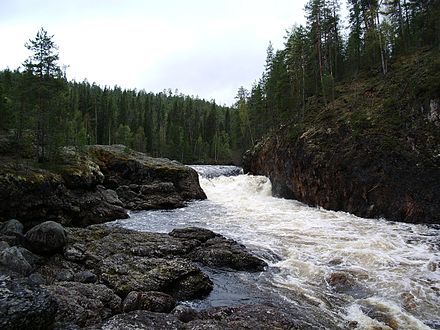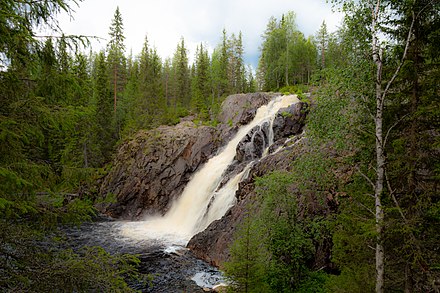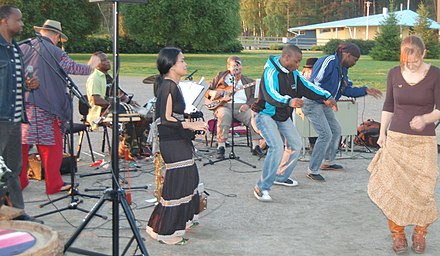Kainuu and Eastern Oulu region
Kainuu and Eastern Oulu region

Kainuu is a region in Northern Finland. For practical purposes, the easternmost parts of Northern Ostrobothnia are also included in this article. Natural landscapes are omnipresent – this is the region where people go to see wildlife of the deep forests. But there are also historical and cultural attractions; the Kuhmo Chamber Music Festival draws a big audience from all of Finland and from abroad.
Cities
- Kajaani - by far the largest town around, castle ruins from the 1600s
- Kuhmo - bears, wolves and wolverines. This is where the nature documentaries are filmed
- Kuusamo - town near the Ruka resort
- Pudasjärvi - transportation hub of some importance
Municipalities
Other destinations
- Ruka – the second most popular ski resort in Finland
- Vuokatti – internationally renowned ski and sports resort, also popular spa
- Oulanka National Park 📍 – one of the most popular national parks and home of the most popular trekking route, the Karhunkierros
- Hiidenportti National Park – impressive gorge and untouched forests
- Rokua National Park 📍 – compact collection of glacial formations
- Syöte National Park – southernmost true fells in Finland
- Hossa National Park 📍 – national park established in 2017 and famous for its prehistoric rock paintings
Understand
Kainuu and the Eastern Oulu region is a peaceful and natural place with little or no pollution problems. In fact, Kainuu was one of the first regions in Finland to start taking care of the environment and nature and stop consuming natural resources. Nature is omnipresent and outdoor activities in the wilderness are present in the daily life of most people. Even in the largest city Kajaani, you do not have to travel far from the city centre to the forest.
Climate
.jpg/440px-Skiing_(8455770686).jpg)
The winters can be harsh, with heavy snowfall and cold temperatures; in Kiutaköngäs has been recorded (typical winter temperatures are much more moderate, though). For wilderness adventures in winter, use a programme service or an appointed guide (check in advance whether you need any preparations yourself), or be sure you know what you are doing. Day trips along trails are often possible independently also in winter, in good weather (but check forecasts and what to expect from the trail itself).
Talk
Like in most of Finland, English is widely spoken. Since Kainuu region neighbours Russia, some places also offer service in Russian, at least near the Russian border.
Get in
There are flights from Helsinki-Vantaa to Kajaani Airport 📍 (IATA: KAJ) and Kuusamo Airport 📍 (IATA: KAO). The eastern north-south line of the Finnish train network connects Kajaani to southern Finland, and there are also trains from Oulu. Further north, intercity bus is the only mode of transportation if you aren't driving. The Finnish road network is dense and the roads are generally in good shape.
From Russia there are the border crossings of Vartius 📍 from Kostomuksha and Kuusamo 📍 (Kuusamo-Суоперя) from northernmost Russian Karelia. There are no passenger trains over the border at Vartius.
The main road to the region from the south is highway 5 from Helsinki via Savonia and Iisalmi to Kajaani, Hyrynsalmi, Suomussalmi and Kuusamo, and on to Kemijärvi. Road 81 leads from Rovaniemi to Kuusamo, road 78 via Posio to Pudasjärvi. Road 20 leads from Oulu to Pudasjärvi, Taivalkoski and Kuusamo, road 22 to Utajärvi, Vaala, Paltamo and Kajaani. Road 28 leads from Kokkola via Kärsämäki and Pyhäntä towards Kajaani.
See Matkahuolto for coaches. E.g.:
- Rukan Taksi ja Huoltopalvelu and Koillismaan Liikenne (+358 40-756-9095 , service possibly only in Finnish) drive from Rovaniemi to Kuusamo.
- Pohjolan Matka serves a route between Oulu and Joensuu via Kajaani.
- Saaga Travel serves a route from Oulu to Kajaani via Vaala.
- Onnibus M9 drives Turku—Tampere—Jyväskylä—Kuopio—Kajaani
Get around
There are a couple of daily coaches along the major highways. Most towns and municipalities have connections from Oulu, Kajaani or both at least once a day. In weekdays of the school year bus connections are more frequent, but in weekends and in summer services are reduced. If you do not have your own car and need to get to a more remote place, you might need to take a taxi. Long taxi rides aren't uncommon in Northern Finland.
See Matkahuolto for normal coach and bus connections. See also Kajaanin seudun joukkoliikenne for public service obligation regional bus routes.
Trains stop only in Kajaani, Kontiomäki and Paltamo, but they may be useful if you travel between those.
By taxi
- Smartphone apps: Valopilkku, 02 Taksi, Menevä, Taksini
- Korpitaxi offers taxi service in Kainuu region
- Otaxi offers taxi service in Eastern Oulu region
See
%2C_Viiksimo%2C_Kainuu_region%2C_Finland_(29058988558).jpg/440px-Brown_bear_(Ursus_arctos),_Viiksimo,_Kainuu_region,_Finland_(29058988558).jpg)

You will see endless forests and bogs, and – if you're lucky – wildlife. Bears, wolves, wolverines, elk (moose), and wild forest reindeer (Finnish: peura, not poro which is domesticated) all have significant populations in the area. In fact, many nature documentaries have been filmed in the forests of Kuhmo, where population density of wild bears and wolves are high. For western bird watchers, these forests are home to some eastern species not easily spotted elsewhere outside Russia.
- Hepoköngäs 📍 - at 24 m one of Finland's highest waterfalls, in Hepoköngäs Nature Reserve, Puolanka; the 600-m trail to the waterfall is accessible by wheelchair.
In winter the northern part of the area get the heaviest annual snowfall in Finland. Snow cover over one meter thick is just normal.
There are also cultural sights:
- The castle ruins in Kajaani 📍 – castle built in the early 1600s
- Hossa rock paintings 📍 – prehistoric paintings on rock
- Paltamo museum of local history 📍
- Puolanka museum of local history 📍
- Ristijärvi White guard and Lotta sister exhibition 📍
- Raate frontier guard museum 📍
- Raate Gate 📍 – memorial and exhibition on the Battle of Raate Road during the Winter War
- Suomussalmi museum of local history 📍
- Kallioniemi estate 📍 – childhood home of and museum on the novelist Kalle Päätalo
The Kuivajärvi 📍 and Hietajärvi 📍 villages in Suomussalmi as well as a the small Rimpi 📍 village in Kuhmo were important for the Karelianism movement: they are the only villages in modern-day Finland that contributed to the Kalevala, and they were visited by ethnologists and artists developing the image of the genuine historic Finnish culture. The three villages are included to the Finnish list of nationally significant built cultural environments.
Do
- Skiing – three major ski resorts are located in the region; Vuokatti in Sotkamo, Ruka in Kuusamo and Iso-Syöte in Pudasjärvi. Around these there are also wide networks of cross country skiing tracks.
- Fishing
- Hiking. There are trails of various kinds in all national parks and between some of them, ranging for one-hour ones suitable even for those with pram or wheelchair to those requiring overnighting in primitive facilities or in a tent, and sometimes finding the route on your own. The right to access allows your finding your own paths also otherwise.
- The 80-km Karhunkierros trail from Hautajärvi through Oulanka National Park to Ruka is legendary. See Oulanka National Park#Do and Ruka#Karhunkierros.
- The UKK trail from Koli to Urho Kekkonen National Park can be used as an extension to the Karhunkierros trail northward or hiked through Syöte National Park and southward. This is a demanding long-distance trail for hardcore hikers, others should choose suitable legs or other trails.
- Camping
- Berry picking and mushroom collecting. Know the species you are going to collect and particularly mind the destroying angel, which resembles some commonly eaten species, especially as young.
- Wildlife watching
Festivals

- LankaFest, Puolanka. Year: 2023. A music festival focusing on rock and heavy music in early July. Puolanka centre.
- Kuhmo Chamber Music Festival](https://kuhmofestival.fi). Year: 2023. Month: July. Leading chamber musicians transfix the town of Kuhmo every July with a skilfully designed festival programme, inimitable concerts, beautiful surroundings and sunlit nights that open the senses to new and sublime delight. The festival is the biggest chamber music festival in Finland (where most cities have their own), with some 70 concerts and 35.000 tickets sold.
Eat
- Rönttönen pie, the best-known speciality in the region of Kainuu, which is a small (about the size of the palm of a hand) open faced pie consisting of a crust made of barley or rye dough, filled with a sweetened mashed potato and berry (most often Lingonberry) filling. Typically, this traditional sweet is served as an accompaniment to a coffee.
Drink
Stay safe
Kainuu is a very safe region. However, outside cities you should be aware of the implications of long distances and cold weather in season.
Go next
If you're coming from the south you'll probably continue all the way to Lapland. If you have a valid visa (or don't need one), Russian Karelia is located east of Kainuu.
Related Wikipedia article: Kainuu
Related Wikipedia article: Northern Ostrobothnia